Whether you ride road, gravel, mountain, or electric bikes, a good bike pump is a must-have for every cyclist. Maintaining the proper tire pressure is critical for comfort, safety, and the performance of your tires on the road or trails.
While they all perform the same basic task, there is a huge variety of pumps with literally hundreds of models to choose from. Whether for high volume, high pressure, seating tubeless tires, or carrying with you on rides, there are lots of great options to keep your bike rolling smoothly.
We rounded up 17 of the best pumps available today and have recommendations for all types of pumps and riders. Our diverse selection includes both high-end and budget-friendly models, high volume and high pressure, digital and analog gauges, and booster pumps for seating tubeless tires.
While testing, we took notes on the type of valves they work with, the ease of attachment at the valve, pumping efficiency, smoothness, stability, accuracy, and readability of gauges, and the overall value and quality of craftsmanship. Our top recommendations are listed below, followed by the best of the rest, which are all worthy options to consider.
Editor’s Note: We refreshed our bike pump guide on November 8, 2024, with the addition of three pumps: the tubeless-boosting Blackburn Chamber, the versatile Blackburn Mammoth CO2 Mini Pump, and the Lezyne Tech Drive HV.
The Best Bike Pumps of 2025
- Valves: Presta and Schrader all-in-one
- Max psi: 160
- Hose length: 46”
- Gauge: Analog
- Weight: 1,692 g
Pros
- Switch between high-volume and high-pressure easily
- Great efficiency in high volume mode
- Stable base
- Large, easy to read analog gauge
- Long hose
- Red color is easy to spot
Cons
- Average all-in-one head connection
- Head can be finicky
- Gauge is not the most accurate
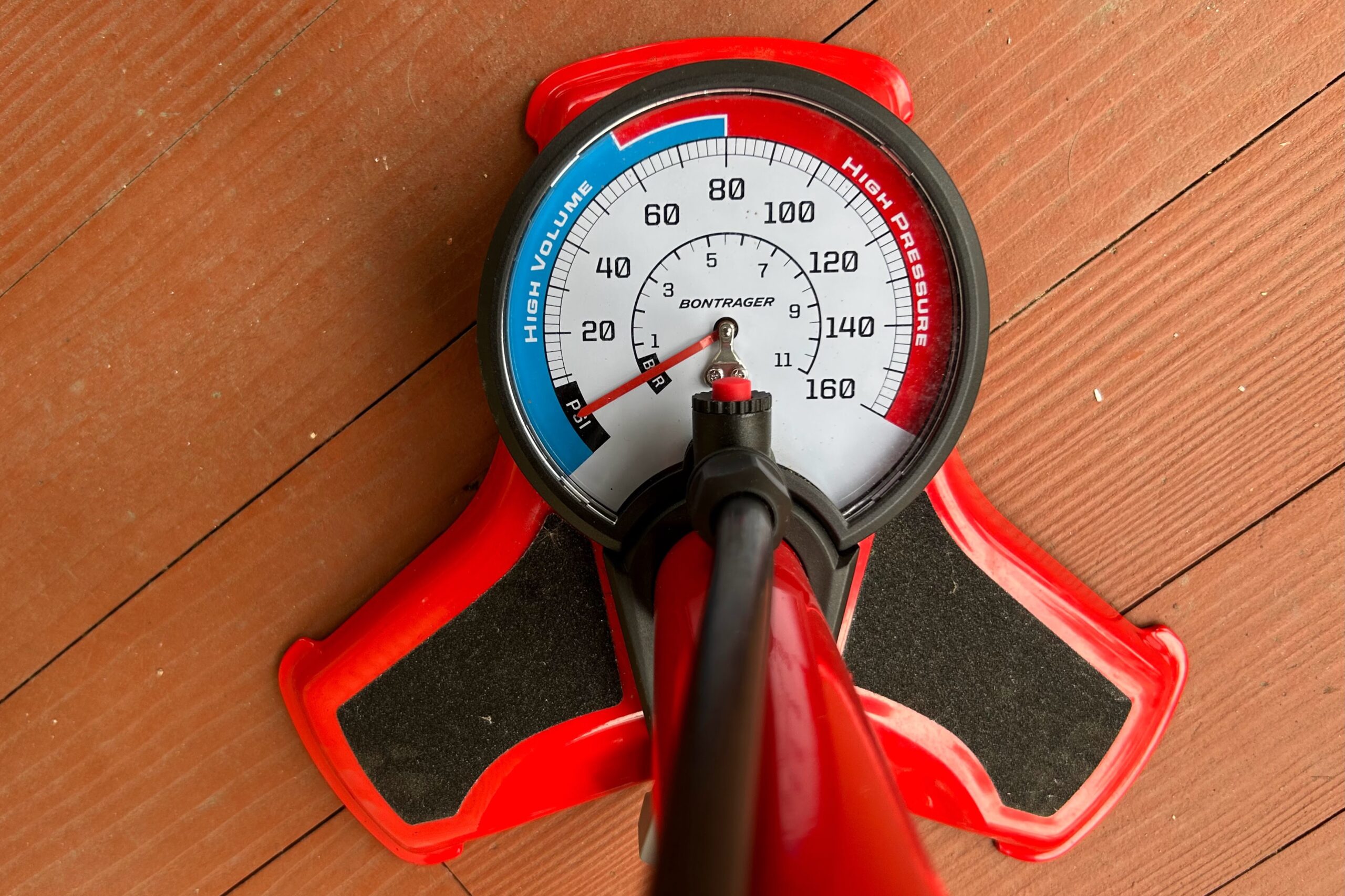
- Valves: Presta and Schrader with two-sided head
- Max psi: 160
- Hose length: 30”
- Gauge: Analog
- Weight: 1,622 g
Pros
- Solid value
- Second most accurate gauge in our testing
- Smooth operation
- Durable
Cons
- Short hose length made less usable being mounted at bottom of pump
- Not the most stable
- Head is difficult to use with one hand
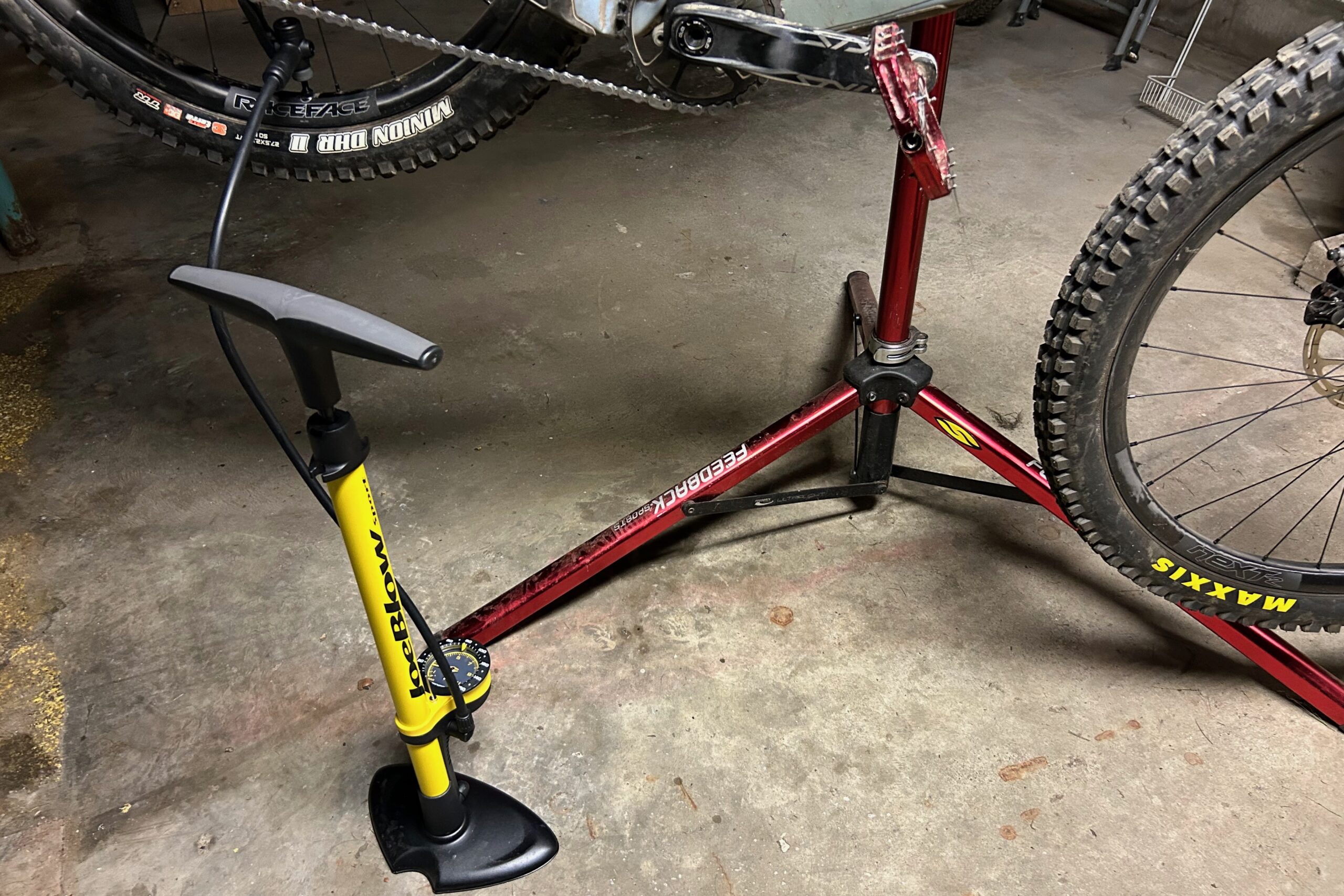
- Valves: Presta and Schrader – flip-able head
- Max psi: 160
- Hose length: 62"
- Gauge: Analog
- Weight: 3,150 g
Pros
- Wide handle with mtb grips = better pumping ergonomics
- Seats tubeless tires with ease
- Dual function – regular pump and tubeless booster
- Durable construction
Cons
- Expensive
- Larger size and heavier weight
- Valves: Presta and Schrader
- Max psi: 120
- Hose length: 40" (102.5 cm)
- Gauge: Analog
- Weight: 1,575 g
Pros
- Very durable
- Powerful
- Accurate
- Beautiful
Cons
- Expensive
- Valves: Schrader for air suspension, includes a Presta adaptor that can be used to fill tires
- Max psi: 350
- Hose length: 48”
- Gauge: Analog
- Weight: 1,593 g
Pros
- Very quick to fill high-pressure, low-volume shocks
- Quite accurate
- Better than using a handheld shock pump when in the shop
- High-quality threaded head chuck
- Braided hose is flexible and long – works well with both shocks and forks
- Stable base
Cons
- Not great for pumping tires – but not really made for pumping tires
- Small changes to shock pressures can be hard to read on analog gauge
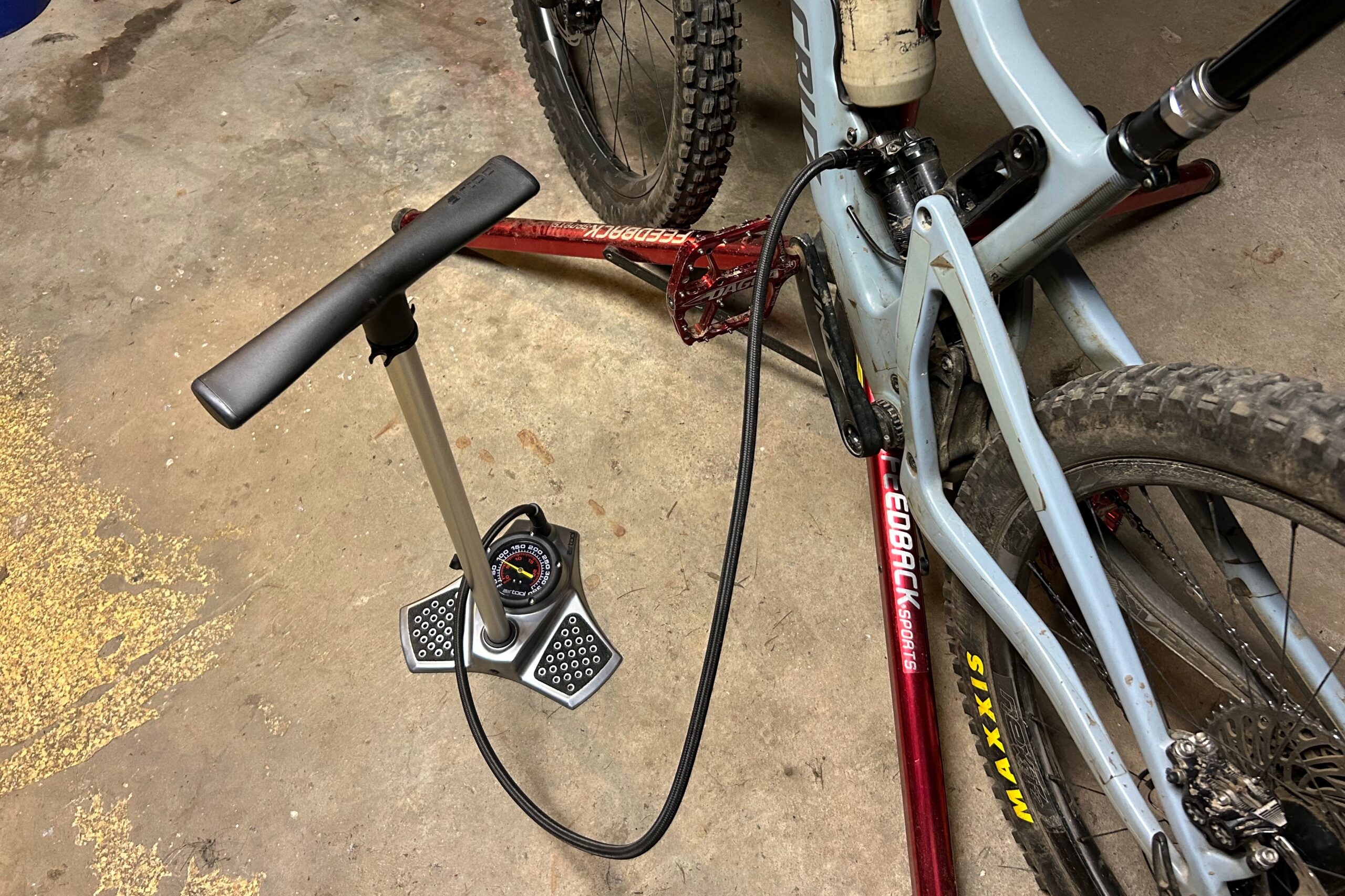
- Valves: Presta and Schrader
- Max psi: 90
- Hose length: 6"
- Gauge: None
- Weight: 131 g (medium)
Pros
- Longer flex hose for easy valve access
- Light weight
- Moves a good volume of air
- Fair price
Cons
- Not great for high pressure applications
- Medium size we tested is fairly long and bulky
- Valves: Reversible Presta and Schrader
- Max psi: 100
- Hose length: 7"
- Gauge: Analog in-line
- Weight: 128 g
Pros
- CNC aluminum construction
- Integrated hose with guage
- Included bike frame mount
- Affordable
Cons
- Guage limits hose flexibility
Other Bike Pumps To Keep Your Tires Inflated
- Valves: Presta
- Max psi: Not specified
- Hose length: 3"
- Gauge: None
- Weight: 134 g
Pros
- Mini-pump and CO2 inflator in one
- Compact size – fits in a jersey pocket
- Light weight
- Good for higher volume applications – mtb and gravel
Cons
- Doesn't work with Schrader valves
- Not great for high pressure pumping
- Valves: Reversible locking, fits Presta and Schrader
- Max psi: 100
- Hose length: 3.5"
- Gauge: None
- Weight: 165 g
Pros
- Ultra-compact design
- Hidden air hose
- Integrated heat sinks
Cons
- Not the easiest to mount to bike frame
- Expensive
- Valves: Presta and Schrader ABS Flip Chuck
- Max psi: 160
- Hose length: 23.6"
- Gauge: Analog
- Weight: 865 g
Pros
- Lightweight
- Lay flat design
- Smaller, packable and storable dimensions
- Great for travel
- Comes with a protective storage bag
Cons
- Less stable
- Shorter hose length
- Shorter height requires bending over for taller users
- Not ideal as an everyday pump
- Valves: Presta and Schrader all-in-one
- Max psi: 160
- Hose length: 34"
- Gauge: Analog
- Weight: 1,090 g
Pros
- Very affordable
- Gets the job done
- Easy to use
- Versatile all-in-one head
Cons
- Shorter hose length
- Not the most stable footing
- Less robust build
- Valves: Presta with Hiro chuck, threaded Schrader
- Max psi: 220
- Hose length: 48”
- Gauge: Digital
- Weight: 1,967 g
Pros
- Hiro chuck works great – easy to use with one hand
- Quality construction
- Supple hose
- Very stable footing with rubber feet
- Digital gauge works great
- Replaceable and rebuildable components
- Extremely smooth pumping action
Cons
- Preload function is not very valuable
- Average accuracy at a high price point
- Fabric handle clasp is very tight
- Extremely expensive
- Valves: Presta and Schrader reversible head
- Max psi: 160 (11 bar)
- Hose length: 50” (127cm)
- Gauge: Analog
- Weight: 1,580 g
Pros
- Good value
- Stable and wide, rubber footed base
- Smooth feel
- Lifetime warranty
- Sturdy, durable construction
Cons
- Not our favorite head lock design, awkward operation and very stiff
- Valves: Presta and Schrader all-in-one
- Max psi: 220
- Hose length: 47”
- Gauge: Analog
- Weight: 1,500 g
Pros
- All-in-one head is easy to use and has a good, sturdy feel
- Relatively efficient
- Easy to read analog gauge with clear color differentiation between high-volume and high-pressure readings
- Greater gauge detail between 0-40 psi
- Metal handle feels solid
- Smooth pumping action
Cons
- Stand is not the most stable in the test
- No rubber padding on bottom of metal foot
- Gauge only goes up to 140 psi
- Valve: Presta and Schrader thread-on
- Max psi: 220
- Hose length: 46"
- Gauge: Analog
- Weight: 1,885 g
Pros
- Slim/sleek
- Does the job
- Fully serviceable
- Moderate price
Cons
- Screw-on valve is less user-friendly
- Valves: Presta and Schrader all-in-one
- Max psi: 160 (11 bar)
- Hose length: 54” (137cm)
- Gauge: Digital
- Weight: 3,002 g
Pros
- Very accurate gauge
- Fast enough airflow to almost fully seat tubeless tires
- 54” hose length increases usability and plays nicely when the bike is on a stand
- Digital gauge is easy to read and repeatable
- Pin and plug hidden in handle
Cons
- Less efficient than a normal floor pump
- Challenging to increase reservoir pressure above 125 psi
- Average all-in-one head connection
- Valves: Presta and Schrader all-in-one
- Max psi: 160
- Hose length: 60”
- Gauge: Analog
- Weight: 3,387 g
Pros
- 60” hose is plenty long
- Simple operation to release reservoir
- Generally easy to use
- Stable
Cons
- Expensive
- Head has a very sloppy feel, loose and gets knocked off easily
- Challenging to fill reservoir fully to 160 psi
- Airflow from reservoir is not quick enough to seat tubeless tires reliably
- Not super efficient
Best Bike Pumps Comparison Chart
| Bike Pump | MSRP | Valves | Max PSI | Hose Length | Gauge | Weight |
|---|---|---|---|---|---|---|
| Bontrager Dual Charger | $75 | Presta/Schrader all-in-one | 160 | 46″ | Analog | 1,692 grams |
| ToPeak Joe Blow Sport III | $60 | Presta/Schrader two-sided | 160 | 30″ | Analog | 1,622 grams |
| Blackburn Chamber Tubeless | $200 | Presta and Schrader | 160 | 62″ | Analog | 3,150 grams |
| Silca Pista Plus | $199 | Presta and Schrader | 120 | 40″ | Analog | 1,575 grams |
| Specialized Air Tool UHP | $100 | Schrader with Presta adapter | 350 | 48″ | Analog | 1,593 grams |
| Lezyne Tech Drive HV | $45 | Presta and Schrader | 90 | 6″ | None | 131 grams |
| Pro Bike Tool High Pressure Mini | $37 | Presta and Schrader | 100 | 7″ | Analog in-line | 128 grams |
| Blackburn Mammoth CO2 Mini-Pump | $55 | Presta | Not specified | 3″ | None | 134 grams |
| Silca Tattico Mini-Pump | $70 | Presta and Schrader | 100 | 3.5″ | None | 165 grams |
| Lezyne CNC Travel Floor Drive | $100 | Presta/Schrader ABS Flip Chuck | 160 | 23.6″ | Analog | 865 grams |
| AerGun X-1000 | $40 | Presta/Schrader all-in-one | 160 | 34″ | Analog | 1,090 grams |
| Silca SuperPista Digital | $349 | Hiro Presta and thread-on Schrader | 220 | 48″ | Digital | 1,967 grams |
| Blackburn Core 3 | $80 | Presta/Schrader reversible | 160 | 50″ | Analog | 1,580 grams |
| Pro Floor Pump Team | $115 | Presta/Schrader all-in-one | 220 | 47″ | Analog | 1,500 grams |
| Lezyne Classic Floor Drive 3.5 | $80 | Presta/Schrader ABS-1 Pro Chuck | 220 | 46″ | Analog | 1,885 grams |
| Bontrager TLR Flash Charger | $160 | Presta/Schrader all-in-one | 160 | 54″ | Digital | 3,002 grams |
| ToPeak Joe Blow Booster | $220 | Presta/Schrader all-in-one | 160 | 60″ | Analog | 3,387 grams |
How We Tested Bike Pumps
Our Expert Testers

Our Testing Process
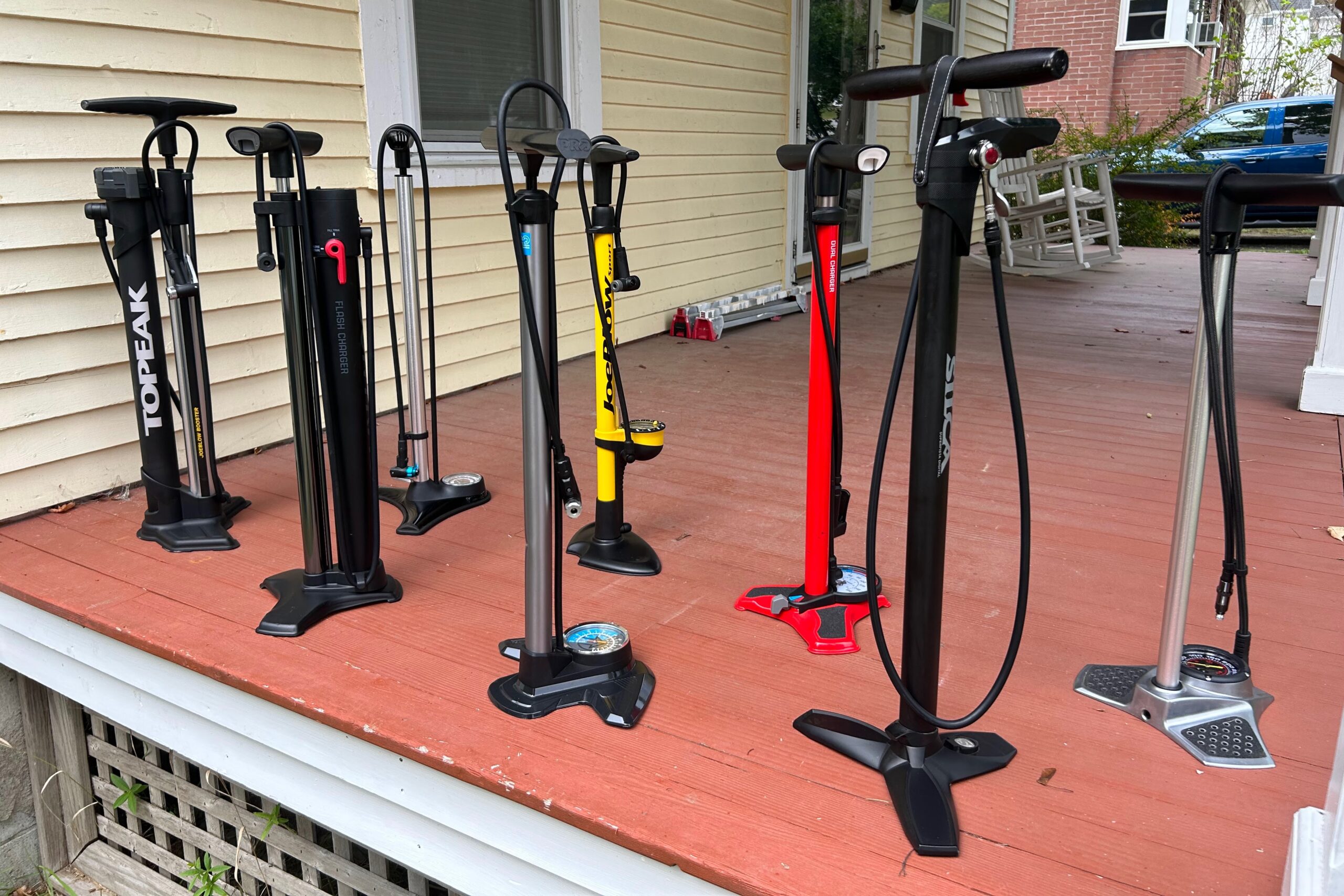
Buying Advice: How to Choose the Best Bike Pump
Types of Bike Pumps
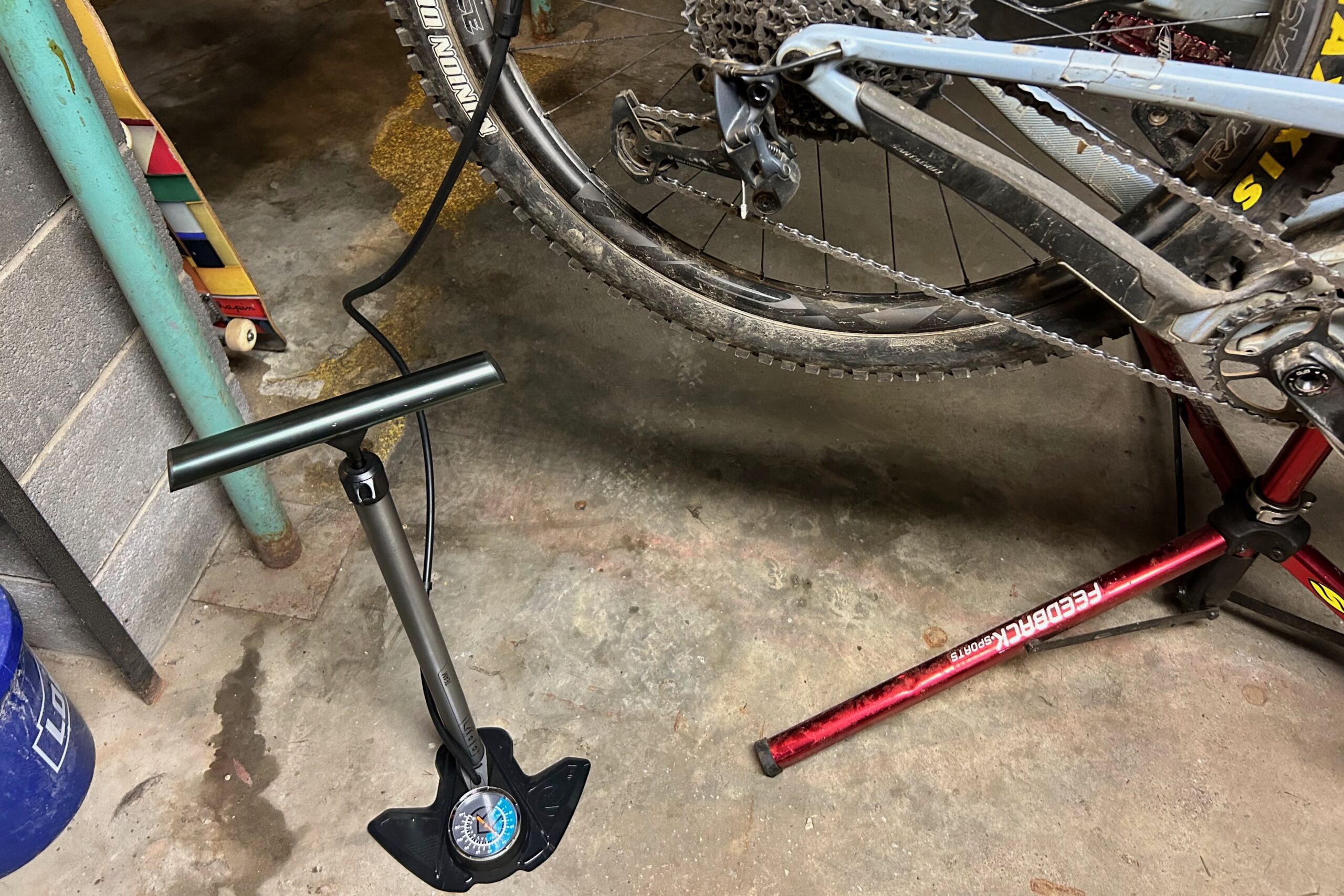
Standard Floor Pumps or Track Pumps
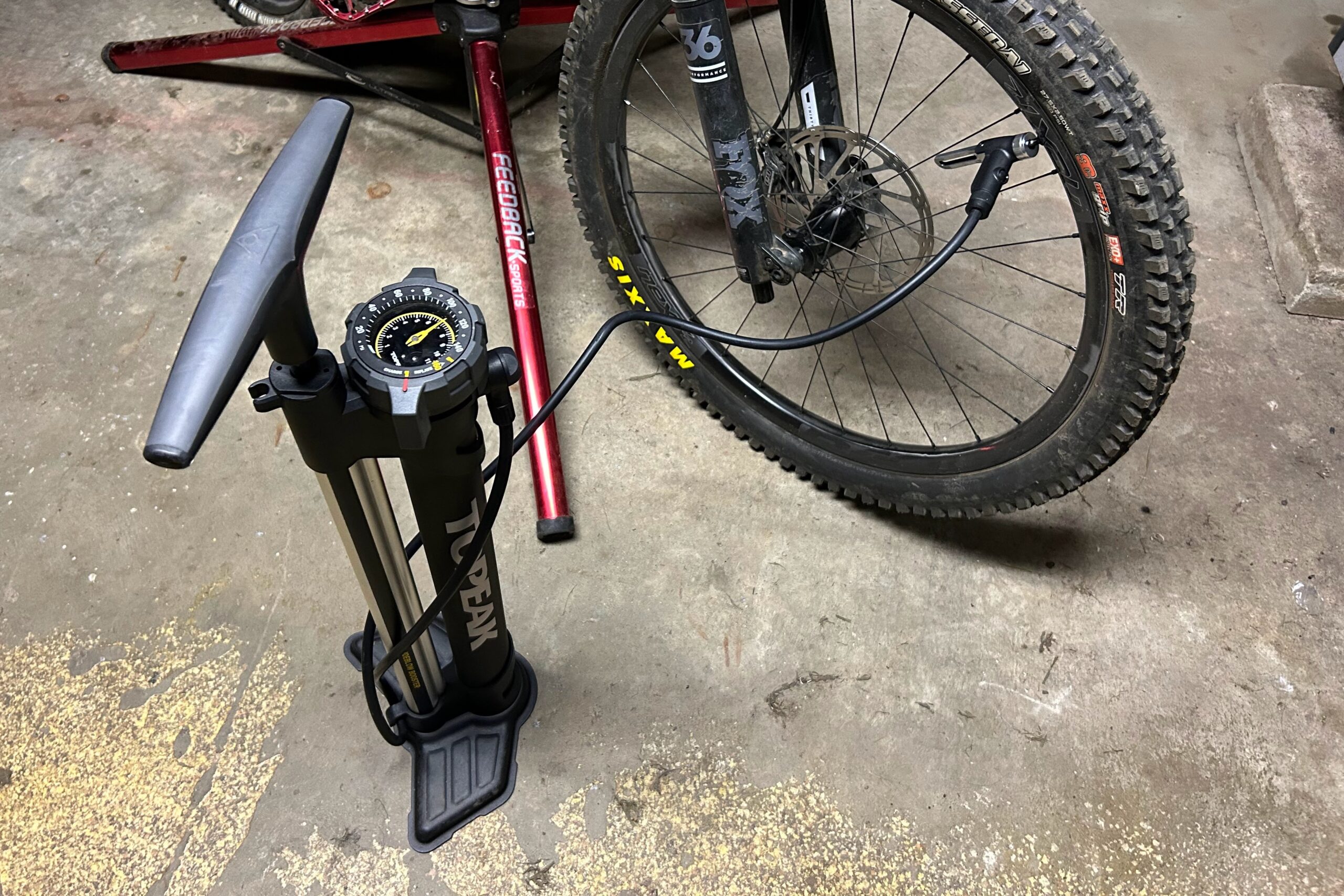
Tubeless Booster Pumps

Mini-Pumps
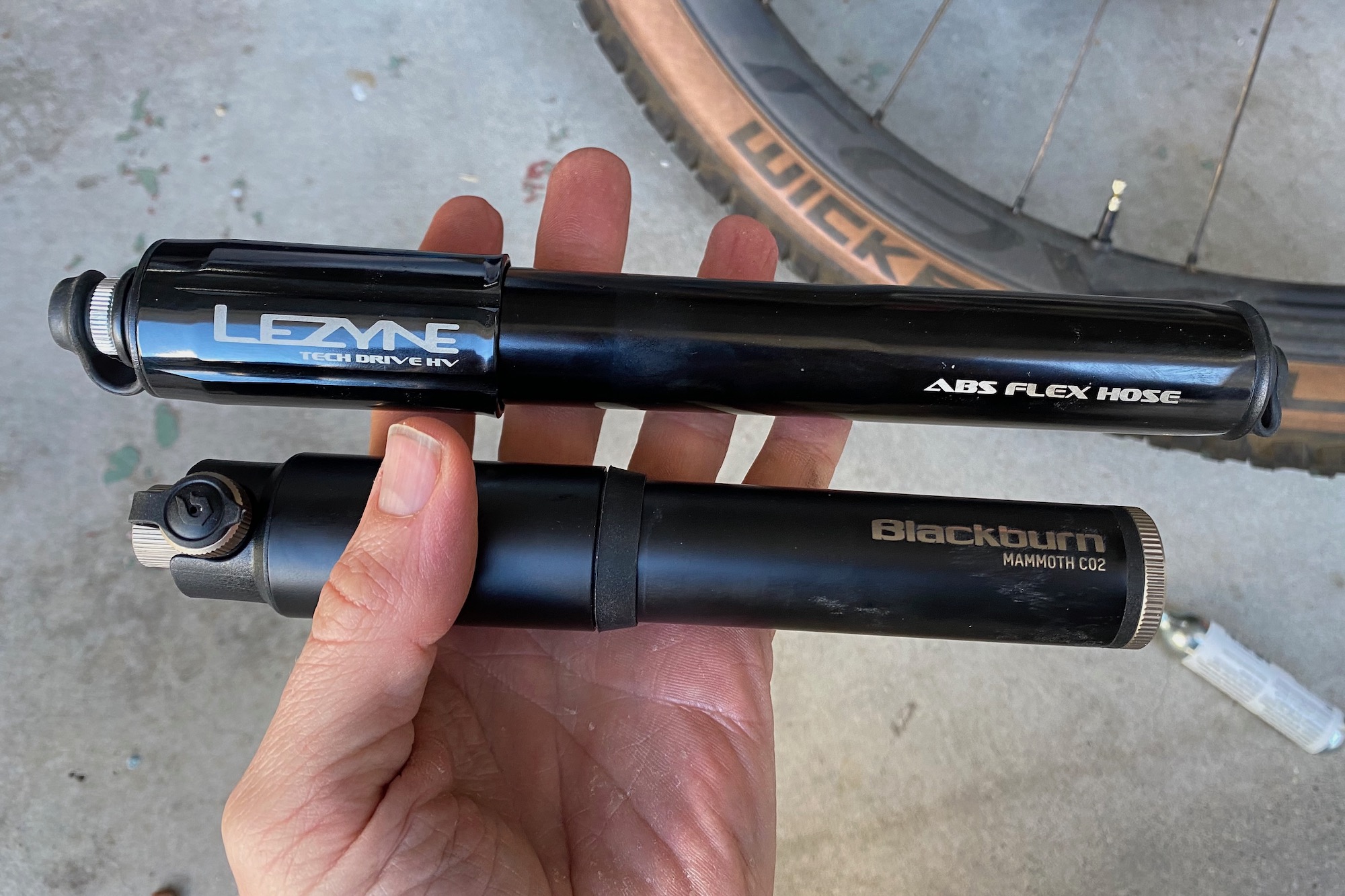
Shock Pumps
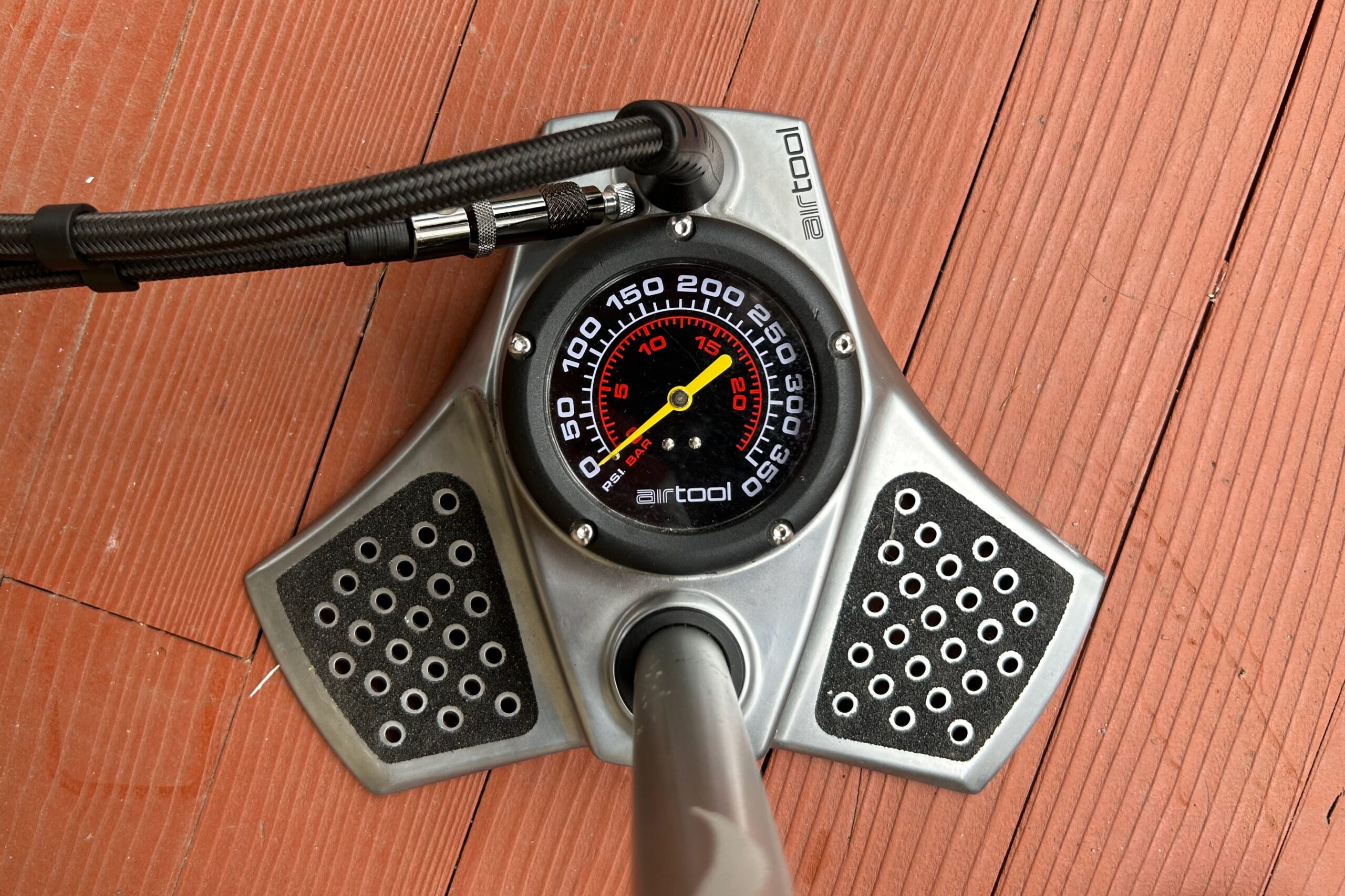
Types of Valves
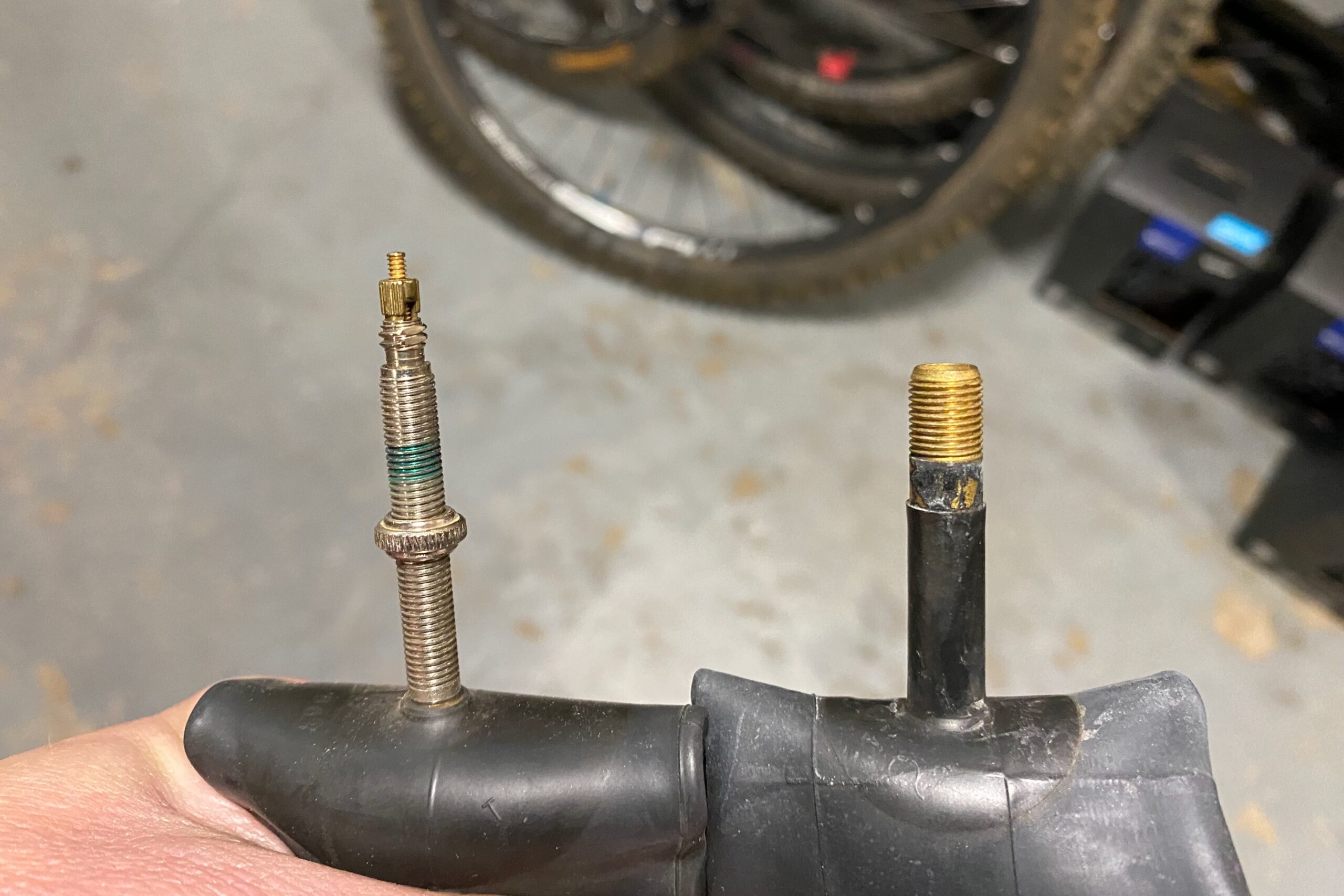
Valve Chucks/Connections/Heads
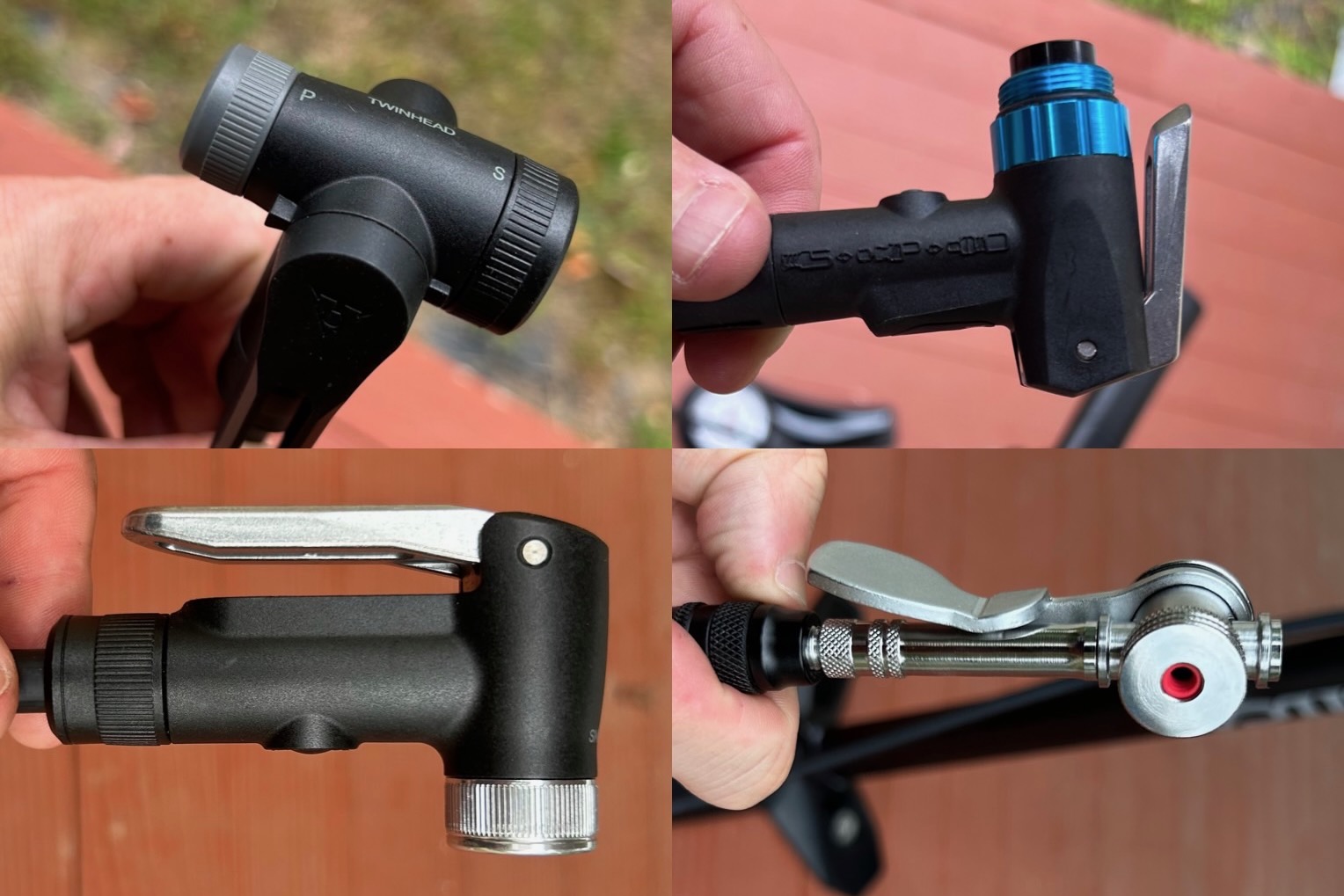
Pumping Efficiency
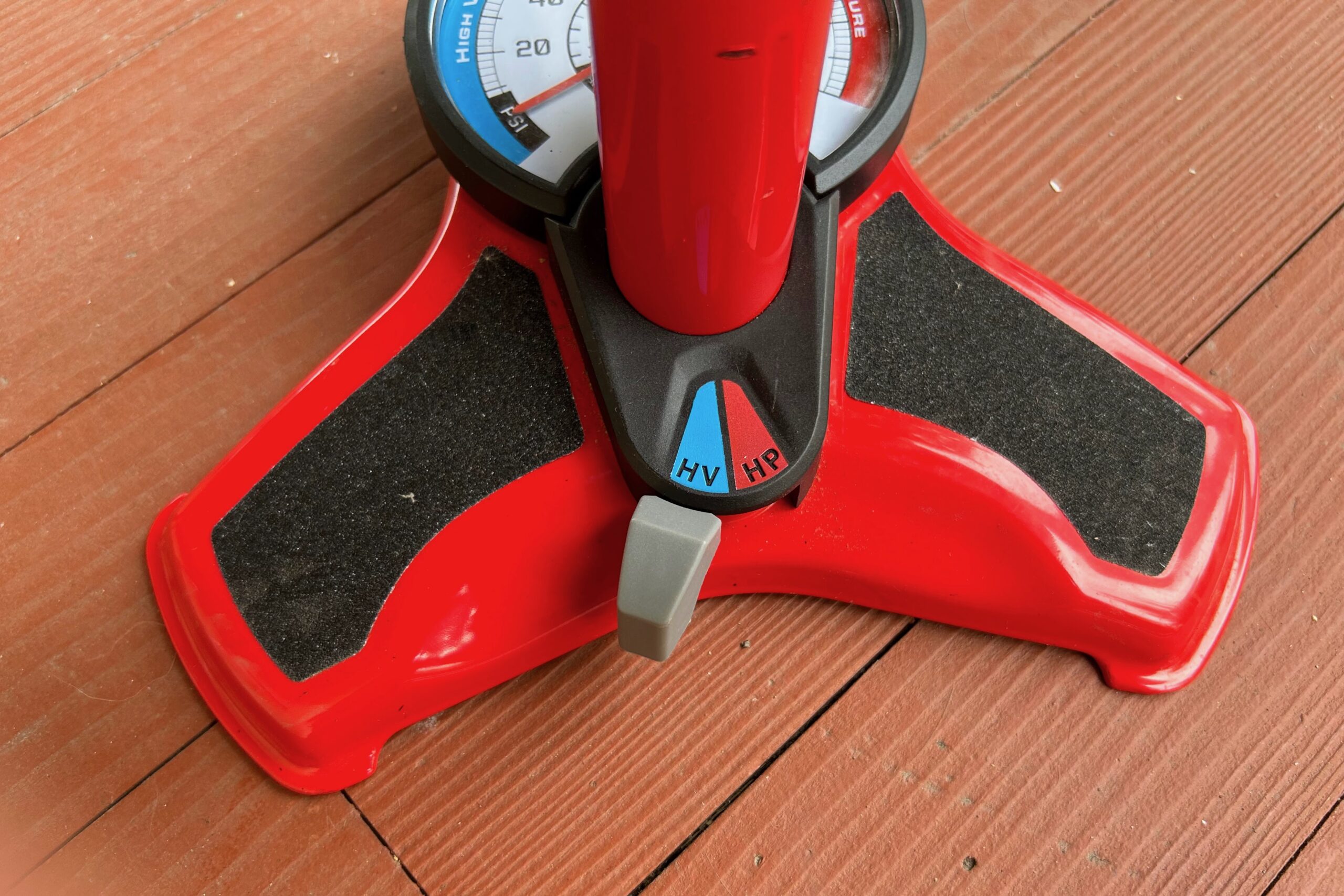
Types of Gauges
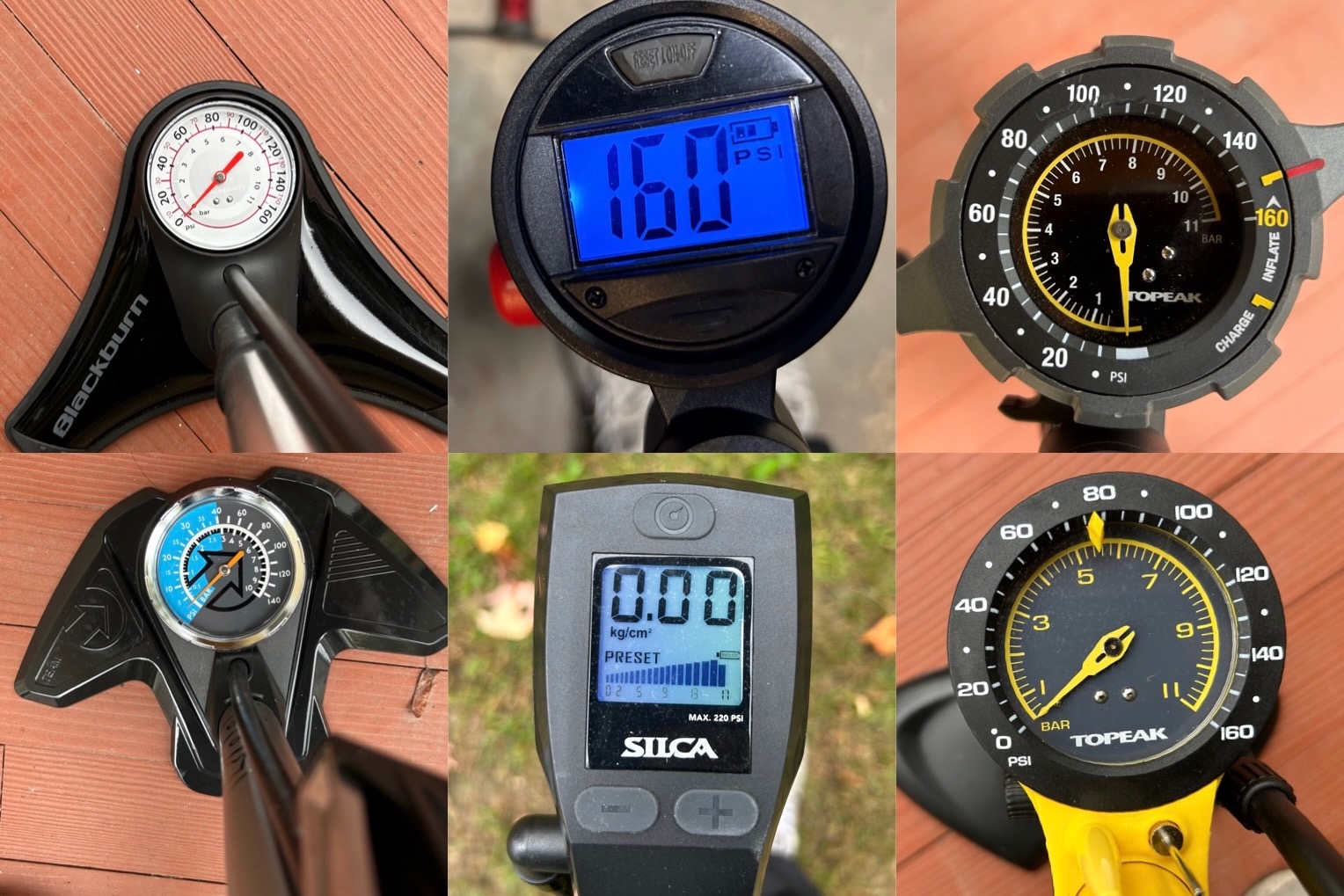
Gauge Accuracy
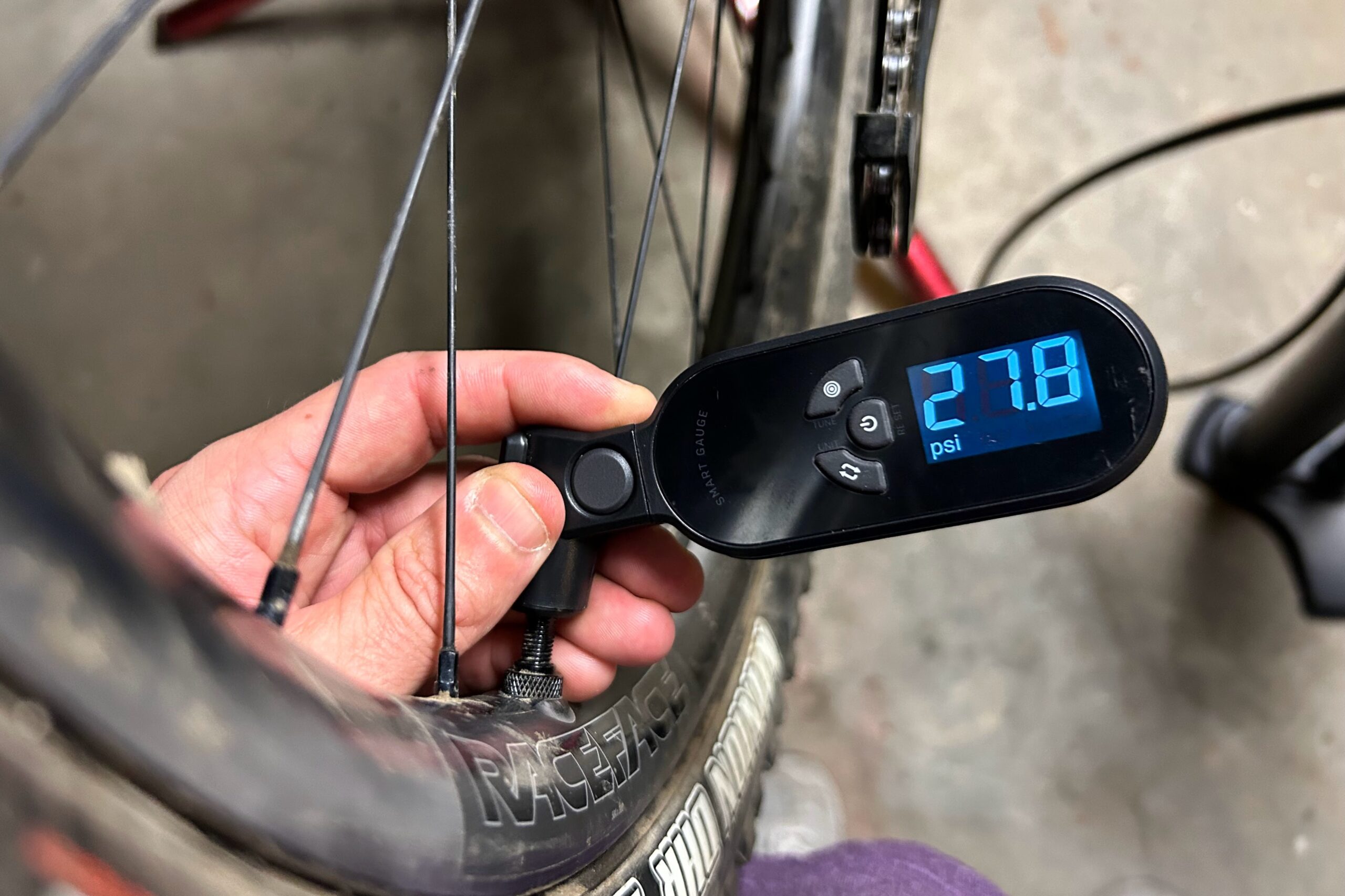
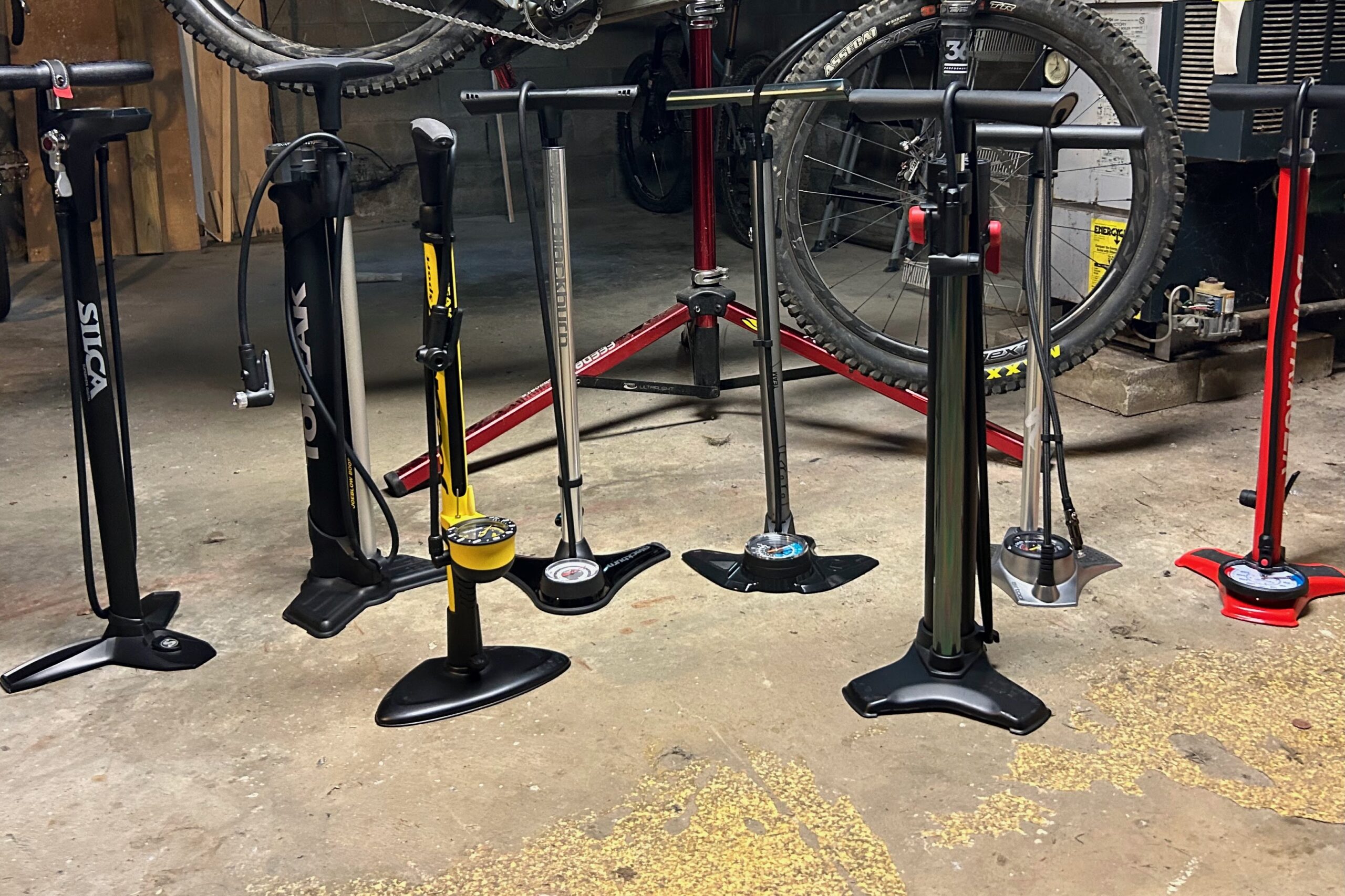
Stability
Durability

Price & Value
Budget
Mid-Tier

Premium
Frequently Asked Questions About Bike Pumps
Well, some track racers do pump their tires to 160 psi or more, but that’s only because they are riding on a perfectly smooth surface in a controlled environment. Regular riding outdoors, on real roads and trails, needs far less tire pressure.
Recently, and especially with tubeless tires becoming the norm, it’s been proven that lower tire pressures yield more comfort, better traction, and improved efficiency. Yep, lower really is better. Brands like Silca have even made guides to help you find your best tire pressure.
So, why do floor pump gauges read so high? Because they need to account for the pressure spikes that occur when pumping. Next time you’re inflating your tire, notice how the needle spikes really high on each stroke. The gauge needs to have room for those spikes or it can be damaged, which means it will no longer be accurate. Specifically, they need 20-30% extra in order to safely cover the higher pressures generated during your pump stroke.
What about portable pumps and CO2 cartridges?
We’ve tested several mini-pumps and have listed our favorites above. Portable hand pumps and CO2 cartridges are intended for use on the trail and should be carried on longer rides, especially on longer rides that you won’t want to walk out of if something goes wrong. But, due to the small size of portable hand pumps, they are time consuming to use with high volume tires and difficult to use with high pressure tires. The Lezyne Tech Drive HV is one of our favorites.
CO2 cartridges are compact and easy to carry in a hip pack (or in frame storage), but they are low volume and can only be used once. Hand pumps and CO2 cartridges are great for use on the road or trail, but we recommend investing in floor pump to make maintenance easier at the house.
An interesting mini-pump option for those who like to use CO2 but also want to have a pump as a backup is the Blackburn Mammoth CO2. The head of this pump comes off and works as a CO2 inflator. That way you can carry one less thing with you while you ride and still be prepared.

What about air compressors?
Air compressors are great for tubeless setup. But, they are also relatively expensive, loud, and difficult to throw in your car for a road trip. While having an air compressor is wonderful, floor pumps are an indispensable piece of gear that makes it easy for any cyclist to keep their tires inflated to their desired pressure. Portable inflators are becoming more common, however, and can be a useful tool to have on hand as well.
It depends on the type of bike and tire you’re running. All bike tires will have a recommended psi range listed on their sidewalls, so try to stay within that range. For most road riders, pumping tires to between 70 and 90 psi is a good starting point, while mountain bikers will run anywhere from 18 to 35 psi depending on the rider’s weight and the terrain. It is often a process of trial and error to find the optimal pressure for your tires, riding style, terrain, or road conditions to get the best performance from them.
Tire pressure should be checked before each ride even though it may not need to be adjusted every time you take out your bike. Some tires will hold air pressure perfectly for extended periods, but over time, and sometimes overnight, small amounts of pressure can leak that can impact your tire’s performance or even be a safety issue. Checking your pressure is quick and easy, and adding air takes only a few seconds, so it is worth doing every time you head out for a ride.
What is the difference between a shock pump and a pump for tires?
Shock pumps are optimized for use with high-pressure, low-volume air suspension components. While most air forks and rear shocks use a standard Schrader valve and shock pumps can be used to fill Schrader tubes (and ultra rare Schrader tubeless valves), they generally have a very low volume stroke and are inefficient for use with tires.

The Best Bike Helmets of 2025
We bring you the best bike helmets for all types of riding, with top picks from Giro, Specialized, Thousand, and more.

The Best Hitch Bike Racks of 2025
We tested the best hitch bike racks for 2025 with options for every budget. Top picks include Thule, Kuat, RockyMounts, and more.



























